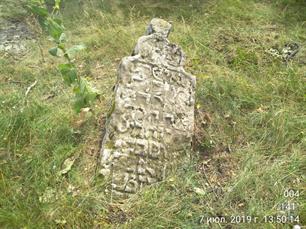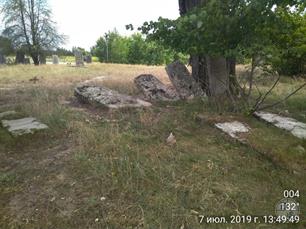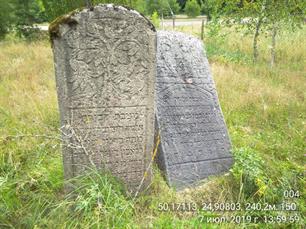Stanislavchyk
Zolochiv district, Lviv region
Year - Total Population - Jews
1880 - 1,545 - 795
1900 - 618 - 446
1921 - 1,153 - 165
1880 - 1,545 - 795
1900 - 618 - 446
1921 - 1,153 - 165
Sources:
- Pinkas Hakehillot Polin: Encyclopedia of Jewish Communities, Poland, Volume II, page 376, published by Yad Vashem, Jerusalem. Translated by Jerrold Landau, JewishGen, Inc.
Photo:
- Hryhoriy Arshynov, European Jewish Cemeteries Initiative. Published by Center for Jewish art
- Pinkas Hakehillot Polin: Encyclopedia of Jewish Communities, Poland, Volume II, page 376, published by Yad Vashem, Jerusalem. Translated by Jerrold Landau, JewishGen, Inc.
Photo:
- Hryhoriy Arshynov, European Jewish Cemeteries Initiative. Published by Center for Jewish art
Stanisławczyk (ukr. Stanislavchyk, Станіславчик) was a private city of the nobility at the end of the 18th and beginning of the 19th centuries. Since it was near the town of Lopatin and not far from the city of Brody, its opportunities for development were weak. It became a village during the two world wars, but it had the status of an urban settlement. The main source of livelihood of the gentile residents was agriculture and forestry work in the forests of the area (manufacture of wooden tiles). There was a beer brewery and liquor distillery in the town.
Jews settled in the town from the time of its founding. Their number reached a peak during the 1800s. The Jewish population dwindled from that time due to emigration to other cities and countries, in search of sources of livelihood. Only a few families remained between the two world wars.
The first Jews worked as lessees for the landowners and tavern owners. When the settlement grew, they worked in small–scale commerce (aside from a few who worked in the lumber and wooden tile trade). They especially worked in peddling in the villages. Only a few worked in trades. At the end of the 19th century, there were only one Jewish tailor, two butchers, one carpenter, and two shoemakers.
When the Jewish population reached its peak, the community maintained a wooden synagogue, the interior of which was of great artistic value.
In 1914, the gentiles prevented the Cossacks from burning it down, as they believed that it was a good portent for their own livelihoods. The ordinary householders worshipped in that synagogue.
The Hassidim set up two additional houses of prayer for themselves: the Husiatyn– Rizhin Hassidim set up a kloiz, and the Belz Hassidim took their place in the Beis Midrash.
There was a tradition in the town that Rabbi Yehoshua Kloizner–Laszczower, one of the scholars of the kloiz in Brody, served as the rabbi for a brief period around the beginning of the 19th century.
One of the descendants of Rabbi Yehoshua, Rabbi Mordechai–Leib Laszczower, served as rabbi of Stanisławczyk at the beginning of the 20th century. His son Rabbi Baruch inherited his position.
The final rabbi of Stanisławczyk was Rabbi Aharon Laszczower, who served during the 1930s.
Rabbi Laszczower succeeded in escaping at the outbreak of the war. He went to Uruguay, and served as a rabbi in Montevideo. He made aliya toward the end of his life and served as a rabbi in Bnei Brak, where he died.
The Achva Zionist organization operated in Stanisławczyk for a period of time. 82 shekel payers voted in the elections for the Zionist Congress in 1935. Apparently, this number included some shekel payers from the neighboring villages. 78 voted for the General Zionists and four for Mizrachi.
Jews settled in the town from the time of its founding. Their number reached a peak during the 1800s. The Jewish population dwindled from that time due to emigration to other cities and countries, in search of sources of livelihood. Only a few families remained between the two world wars.
The first Jews worked as lessees for the landowners and tavern owners. When the settlement grew, they worked in small–scale commerce (aside from a few who worked in the lumber and wooden tile trade). They especially worked in peddling in the villages. Only a few worked in trades. At the end of the 19th century, there were only one Jewish tailor, two butchers, one carpenter, and two shoemakers.
When the Jewish population reached its peak, the community maintained a wooden synagogue, the interior of which was of great artistic value.
In 1914, the gentiles prevented the Cossacks from burning it down, as they believed that it was a good portent for their own livelihoods. The ordinary householders worshipped in that synagogue.
The Hassidim set up two additional houses of prayer for themselves: the Husiatyn– Rizhin Hassidim set up a kloiz, and the Belz Hassidim took their place in the Beis Midrash.
There was a tradition in the town that Rabbi Yehoshua Kloizner–Laszczower, one of the scholars of the kloiz in Brody, served as the rabbi for a brief period around the beginning of the 19th century.
One of the descendants of Rabbi Yehoshua, Rabbi Mordechai–Leib Laszczower, served as rabbi of Stanisławczyk at the beginning of the 20th century. His son Rabbi Baruch inherited his position.
The final rabbi of Stanisławczyk was Rabbi Aharon Laszczower, who served during the 1930s.
Rabbi Laszczower succeeded in escaping at the outbreak of the war. He went to Uruguay, and served as a rabbi in Montevideo. He made aliya toward the end of his life and served as a rabbi in Bnei Brak, where he died.
The Achva Zionist organization operated in Stanisławczyk for a period of time. 82 shekel payers voted in the elections for the Zionist Congress in 1935. Apparently, this number included some shekel payers from the neighboring villages. 78 voted for the General Zionists and four for Mizrachi.
We have no information about the annals of the Jews of Stanisławczyk during the era of Soviet rule (1939–1941).
The Germans entered the town on June 25, 1941. The Soviets retreated in haste. This prevented the Jews who were prepared to go escape with them from doing so.
The Ukrainian population attacked the Jews already on the day following the conquest, on June 26. They beat the Jews and pillaged their property.
In the autumn of 1941, several young Jews of Stanisławczyk joined the group of forced laborers from the residents of the area who were sent to the Plochow Labor Camp.
During the spring and summer months of 1942, the Jews of Stanisławczyk made efforts to overcome the tribulations of hunger and illness. During that period, the men worked at forced labor, especially in agriculture.
The Ukrainian policemen who accompanied them tortured them.
When word arrived in October 1942 that an aktion was imminent, the members of Judenrat went around from house to house at night, informing the members of the community about what was about to happen, and advising them to hide. Many Jews did indeed leave the town that night, and escaped to the village of Napkova, where a significant number of farmers were willing to grant refuge to the escaping Jews.
Other groups of Jews of Stanisławczyk hid in the nearby forests. The Germans and Ukrainian police combed the town, gathered the Jews that did not escape, and joined them with the other Jews of the region, especially with the Jews of Lopatin. They were transferred to Kamionka Strumiłowa, from where they were deported to Belzec. The Germans and Ukrainians continued to hunt for those in hiding. Most were captured and murdered.
The final Jews that remained in Stanisławczyk were ordered to move to the Brody Ghetto on December 30, 1942. Thus, the place became Judenrein.
The Germans entered the town on June 25, 1941. The Soviets retreated in haste. This prevented the Jews who were prepared to go escape with them from doing so.
The Ukrainian population attacked the Jews already on the day following the conquest, on June 26. They beat the Jews and pillaged their property.
In the autumn of 1941, several young Jews of Stanisławczyk joined the group of forced laborers from the residents of the area who were sent to the Plochow Labor Camp.
During the spring and summer months of 1942, the Jews of Stanisławczyk made efforts to overcome the tribulations of hunger and illness. During that period, the men worked at forced labor, especially in agriculture.
The Ukrainian policemen who accompanied them tortured them.
When word arrived in October 1942 that an aktion was imminent, the members of Judenrat went around from house to house at night, informing the members of the community about what was about to happen, and advising them to hide. Many Jews did indeed leave the town that night, and escaped to the village of Napkova, where a significant number of farmers were willing to grant refuge to the escaping Jews.
Other groups of Jews of Stanisławczyk hid in the nearby forests. The Germans and Ukrainian police combed the town, gathered the Jews that did not escape, and joined them with the other Jews of the region, especially with the Jews of Lopatin. They were transferred to Kamionka Strumiłowa, from where they were deported to Belzec. The Germans and Ukrainians continued to hunt for those in hiding. Most were captured and murdered.
The final Jews that remained in Stanisławczyk were ordered to move to the Brody Ghetto on December 30, 1942. Thus, the place became Judenrein.

- Home
- Shtetls
- Vinnytsia region
- Volyn region
- Dnipro region
- Donetsk region
- Zhytomyr region
- Zakarpattia region
- Zaporizhzhia region
- Ivano-Frankivsk region
- Kyiv region
- Kropyvnytskyi region
- Luhansk region
- Lviv region
- Mykolayiv region
- Odessa region
- Poltava region
- Rivne region
- Sumy region
- Ternopil region
- Kharkiv region
- Kherson region
- Khmelnytskyi region
- Chernihiv region
- Chernivtsi region
- Cherkasy region
- Crimea
- Synagogues
- Cemeteries
- Objects & guides
- Old photos
- History
- Contact
Jewish towns of Ukraine
Jewish towns of Ukraine
My shtetl
My shtetl
Donate





